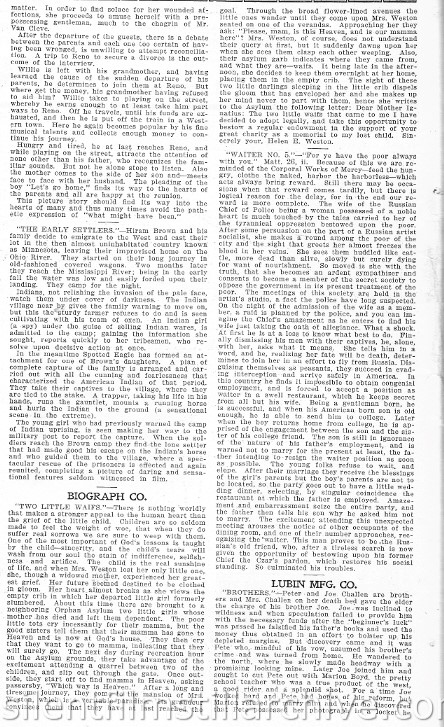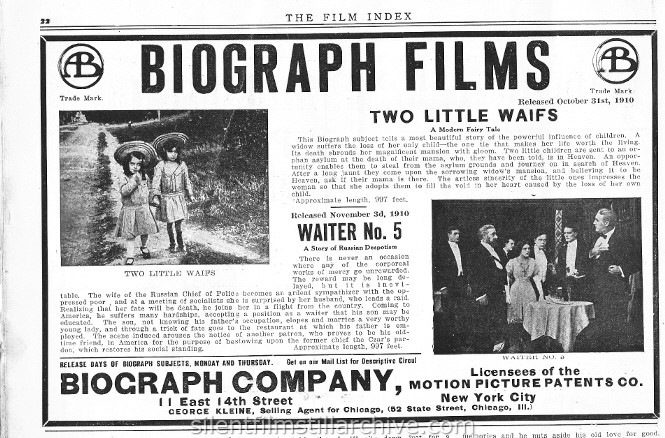![]()

Two Little Waifs (1910)

BIOGRAPH CO.
"TWO LITTLE WAIFS." - There is nothing worldly that makes a stronger appeal to the human heart than the grief of the little child. Children are so seldom made to feel the weight of woe, that when they do suffer real sorrows we are sure to weep with them. One of the most important of God's lessons is taught by the child - sincerity, and the child's tears will wash from our soul the stain of indifference, selfishness and artifice. The child is the real sunshine of life, and Mrs. Weston lost her only little one, she, though a widowed mother, experienced her greatest grief. Her future seemed destined to be clothed in gloom. Her heart almost breaks as she views the empty crib in which her departed little girl formerly slumbered. About this time there are brought to a neighboring Orphan Asylum two little girls whose mother had died and left them dependent. The poor little tots cry incessantly for their mamma, but the good sisters tell them that their mamma has gone to heaven and is now at Gof's house. They then cry that they want to go to mamma, indicating that they will surely go. The next day during recreation hour on the Asylum grounds, they take advantage of the excitement attending a quarrel between two of the children, and slip out through the gate. Once outside, they start off to find mamma in Heaven, asking passerby, "Which way is Heaven." After a long and tiresome journey, they come to the mansion of Mrs. Weston, which is a veritable paradise. Its grandeur convinces them that they have at last reached the goal. Through the broad flower-lined avenues the little ones wander until they come upon Mrs. Weston seated on one of the verandas. Approaching her they ask: "Please, mam, is this Heaven, and is our mamma here"? Mrs. Weston, of course, does not understand their query at first, but it suddenly dawns upon her when she sees them clasp each other weeping. Also, their asylum garb indicates where they came from, and what they are - waifs. It being late in the afternoon, she decides to keep them overnight at her home, placing them in the empty crib. The sight of these two little darling sleeping in the little crib dispels the gloom that has enveloped her and she makes up her mind never to part with them, hence she writes to the Asylum the following letter: Dear Mother Ignatius: The two little waifs that came to me I have decided to adopt legally, and take this opportunity to bestow a regular endowment in the support of your great charity as a memorial to my lost child. Sincerely your (sic), Helen E. Weston.

BIOGRAPH FILMS
AB Trade Mark
Released October 31st, 1910
TWO LITTLE WAIFS
A Modern Fairy Tale
This Biograph subject tells a most beautiful story of the powerful influence of children. A widow suffers the loss of her only child - the one tie that makes her life worth the living. Its death shrouds her magnificent mansion with gloom. Two little children are sent to an orphan asylum at the death of their mama, who, they have been told, is in heaven. An opportunity enables them to steal from the asylum grounds and journey on in search of Heaven. After a long jaunt they come upon the sorrowing widow's mansion, and believing it to be Heaven, ask if their mama is there. The artless sincerity of the little ones impresses the woman so that she adopts them to fill the void in her heart caused by the loss of her old child.
Approximate length, 997 feet.
Release Days of Biograph Subjects, Monday and Thursday
Get on our Mail List for Descriptive Circul (sic)
BIOGRAPH COMPANY,
Licensees of the MOTION
PICTURE PATENTS CO.
11 East 14th Street
New York City
From The Film Index, November 5, 1910, pages 14 and 22
with Grace Henderson, Verner Clarges and Kate Bruce. Directed by D. W. Griffith. Biograph / General Film.
More Information on this film...

This work (Two Little Waifs (1910), by
Biograph),
identified by
Bruce Calvert, is free of known copyright
restrictions.
Books
(none)
Last Modified May 23, 2012.



















